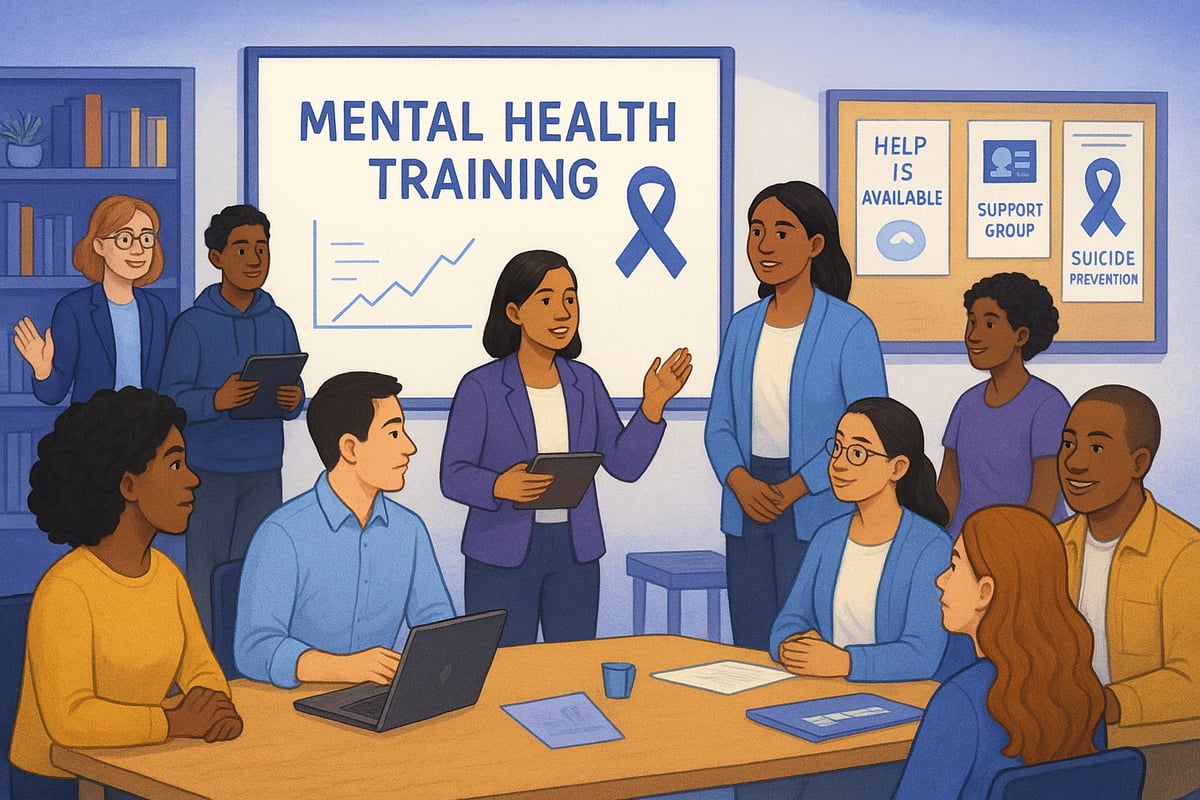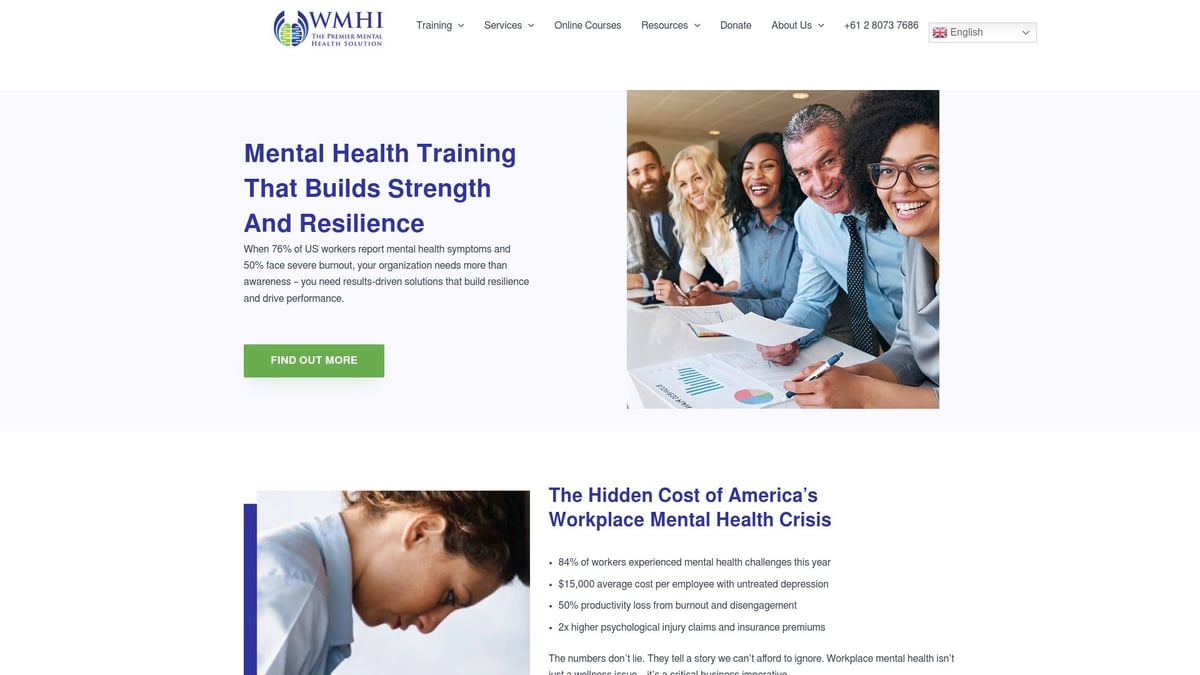Every year, over 700,000 people die by suicide globally. Prevention starts with awareness and effective training. In 2025, the need for mental health literacy continues to grow as more organizations and communities recognize the value of proactive support.
This guide will demystify asist mental health training for beginners, giving you clear steps to identify, respond to, and support those at risk. You will learn what asist training is, its core principles, a step-by-step beginner’s guide, and practical tips for real-world application.
Take the first step to become a mental health ally—your skills can save lives.
Understanding Asist Mental Health Training: Foundations and Purpose
What is Asist Mental Health Training?
Asist mental health training is a globally recognized program known as Applied Suicide Intervention Skills Training. Developed by LivingWorks, this evidence-based initiative has equipped over 2 million people worldwide with vital suicide prevention skills.
At its core, asist mental health training delivers practical, hands-on strategies to help individuals recognize and respond to suicide risk in real-time. Updated regularly to reflect best practices, the training is designed to be effective in both community and workplace settings.
For example, many organizations integrate asist mental health training into their employee support systems, while community groups use it to empower local volunteers with lifesaving skills.
Why Suicide Prevention Skills Matter in 2025
The need for asist mental health training has never been more urgent. In the years following the pandemic, mental health challenges have risen sharply, with suicide now a leading cause of death for people aged 15 to 44. The World Health Organization reports a 10 percent increase in suicide rates across some regions since 2020.
Early intervention is crucial—most suicides are preventable when someone is equipped with the right knowledge and confidence. Reducing stigma is essential for effective prevention. If you want to learn more about overcoming barriers, see breaking stigma around mental health at work.
Every timely conversation, backed by asist mental health training, can be the difference between life and loss.
Core Principles and Learning Objectives of Asist
Asist mental health training is grounded in empathy, non-judgment, and active listening. The curriculum teaches you to spot warning signs, understand risk factors, and engage in supportive dialogue.
A central feature is the “Pathway for Assisting Life” (PAL) model, a structured process that guides intervention from initial recognition to connecting someone with ongoing support.
Participants build confidence through role-play and practical simulations. These exercises help you practice difficult conversations in a safe, supportive environment.
Key learning objectives include:
- Recognizing verbal, behavioral, and situational cues of suicide risk
- Building rapport and trust with at-risk individuals
- Creating collaborative safety plans to reduce immediate danger
- Promoting safety and linking people to professional help
Asist mental health training also emphasizes the importance of self-care for those providing support, ensuring you can sustain your ability to help others over time.
Who Should Take Asist Training?
Asist mental health training is designed for everyone, regardless of prior experience. Educators, managers, healthcare professionals, community leaders, and members of the general public all benefit from these skills.
Organizations with asist mental health training report intervention rates 30 percent higher than those without. The program’s inclusive approach makes it suitable for diverse workplaces, schools, and families.
Whether you are seeking to support colleagues, students, friends, or loved ones, asist mental health training equips you to make a meaningful difference in your community.

Step-by-Step Guide: How to Get Started with Asist Training in 2025
Embarking on your asist mental health training journey is a meaningful commitment. This guide will walk you through each step, so you feel confident, equipped, and ready to make a difference in suicide prevention.

Step 1: Recognizing the Signs of Suicide Risk
The first step in asist mental health training is learning to spot the warning signs of suicide risk. These signs often appear as changes in behavior, mood, or communication. Common indicators include social withdrawal, expressing feelings of hopelessness, or talking about wanting to die.
Look out for behavioral cues like giving away possessions or sudden mood swings. Verbal cues may involve statements such as “I can’t go on” or mentioning feeling trapped. Situational cues can include recent losses, trauma, or significant life changes.
It is important to remember that 80% of people who attempt suicide show warning signs beforehand. For instance, in a workplace setting, a colleague may start missing deadlines, isolate themselves, or express overwhelming stress. Early recognition, as emphasized in asist mental health training, can be life saving.
Step 2: Preparing for the Asist Training Experience
Before starting asist mental health training, it is essential to choose the right workshop and set clear expectations. Accredited ASIST workshops are available both locally and online, accommodating various schedules and learning preferences.
Workshops typically last two days and include interactive elements such as group discussions and role plays. When registering, check for prerequisites and confirm the facilitators are certified. You can compare in-person and virtual outcomes, as both formats deliver effective results.
To find upcoming sessions, visit resources like ASIST Training Events in the United States. This will help you locate reputable training providers and ensure your asist mental health training experience is recognized and credible.
Step 3: Core Components of the Asist Workshop
During asist mental health training, you will engage with a structured, interactive curriculum. The workshop is designed to build practical skills through real-world scenarios and collaborative exercises.
Key modules cover attitudes toward suicide, intervention models, and the Pathway for Assisting Life (PAL) framework. Expect group work, where you will practice active listening and empathy, and participate in role-play simulations to reinforce your learning.
Participants receive feedback from trainers and peers, which fosters confidence and skill development. For example, you might simulate a conversation with someone at risk, applying the PAL model to guide your intervention. This hands-on approach is central to asist mental health training effectiveness.
Step 4: Practicing Safe and Effective Interventions
Putting your asist mental health training into action means using structured intervention techniques. The PAL model helps guide these conversations, ensuring you approach the person with empathy and without judgment.
Start by building rapport and trust. Use open-ended questions and listen actively. Collaborate with the person to create a safety plan, focusing on immediate safety and linking them to further support.
Data shows that 95% of trainees report increased confidence in their skills after asist mental health training. Practice is key—role-play scenarios and feedback sessions prepare you for real-life situations where your intervention could save a life.
Step 5: Post-Training Application and Ongoing Learning
After completing asist mental health training, applying your skills in everyday settings is crucial. Use your training at work, in family life, and within your community to support those at risk. Continuous learning is important for maintaining confidence and effectiveness.
Consider enrolling in refresher courses or advanced modules to deepen your understanding. Many organizations offer alumni networks, where you can share experiences and seek peer support. Tracking your interventions and reflecting on personal growth helps measure the impact of your asist mental health training.
A success story: A manager who completed asist mental health training was able to recognize an employee in crisis, intervene early, and connect them to professional help, leading to a positive outcome. For ongoing growth, explore recommended resources, such as reading materials, podcasts, and online courses. Staying engaged ensures you remain an effective mental health ally.
Integrating Asist Training into Workplaces and Communities
Creating lasting change in suicide prevention requires more than individual skill—it demands a collective effort across workplaces, schools, and communities. Integrating asist mental health training into these environments lays the foundation for a culture of safety, empathy, and proactive support.

The Role of Organizations in Suicide Prevention
Organizations play a pivotal role in advancing suicide prevention. By embedding asist mental health training into their culture, businesses, schools, and community groups become catalysts for change.
- Open dialogue: Leadership should encourage honest conversations about mental health.
- Visibility of resources: Make support and referral options easy to find.
- Training champions: Identify staff to lead by example and support peers.
Workplaces with regular mental health training report a 25 percent reduction in absenteeism. For example, a school district integrating asist mental health training saw more engaged staff and earlier identification of students at risk. By adopting a structured approach, organizations empower their people to recognize and respond to warning signs, creating a safety net for all.
Building a Supportive Environment for Intervention
A supportive environment is essential for effective intervention. Establishing clear policies and protocols for mental health crises ensures everyone knows how to respond.
- Peer support networks: Foster teams who can provide immediate help.
- Mental health champions: Train select individuals to guide colleagues during crises.
- Enhanced EAPs: Employee Assistance Programs become more impactful when infused with asist mental health training skills.
After training, 60 percent of employees report feeling safer discussing mental health with colleagues. Practical strategies for cultivating this atmosphere can be found in resources like how to support mental health in the workplace. When staff feel supported, early intervention becomes the norm rather than the exception.
Overcoming Barriers to Implementation
Despite its proven benefits, implementing asist mental health training can face resistance. Stigma, budget constraints, and lack of understanding are common obstacles.
- Address stigma: Normalize conversations around mental health through regular communications.
- Resource allocation: Prioritize training in budgets by highlighting its return on investment.
- Leadership buy-in: Secure executive support by demonstrating the program’s positive impact.
A community center, for instance, overcame cultural resistance by involving local leaders and adapting materials to reflect community values. By addressing barriers with empathy and strategic planning, organizations can make asist mental health training accessible and effective for all.
Measuring Impact and Success
Tracking the success of asist mental health training is crucial for continuous improvement. Organizations should use a combination of quantitative and qualitative data to measure outcomes.
| Metric | Pre-Training | Post-Training |
|---|---|---|
| Intervention Rates | 10% | 40% |
| Referrals | 25 | 55 |
| Employee Satisfaction | Moderate | High |
- Surveys and feedback: Collect regular input from participants.
- Incident logs: Monitor interventions and outcomes.
- Review cycles: Analyze data quarterly to refine strategies.
One organization reported a 40 percent increase in help-seeking behavior after implementing asist mental health training. By reviewing key performance indicators and sharing success stories, organizations can sustain momentum and drive meaningful change.
Real-World Case Studies and Success Stories
Across diverse sectors, asist mental health training has proven its value through compelling, real-world outcomes. These case studies demonstrate the program’s tangible benefits, from corporations to communities and educational settings.
Workplace Success Story: Corporate Asist Rollout
A leading global company recently introduced asist mental health training to its entire management team. Within six months, the organization reported a 35 percent drop in critical incidents related to mental health crises. Employees shared that they felt more empowered to reach out and support colleagues in distress.
The company’s HR director noted, “We have seen a real shift in culture. Managers are more confident, and employees feel safer.” These improvements mirror success stories from broader implementations, such as the DPS Expands ASIST Training Statewide initiative, which showcases how asist mental health training is being scaled to protect entire workforces.
Community Impact: Grassroots Suicide Prevention
In one city, a nonprofit organization equipped over 100 volunteers with asist mental health training. This grassroots effort led to more than 50 successful interventions in a single year, especially among at-risk youth. Volunteers partnered with local mental health services to provide ongoing support and bridge gaps in care.
Key factors for success included:
- Timely recognition of warning signs
- Strong collaboration with professionals
- Consistent follow-up and peer support
These outcomes highlight how asist mental health training empowers community members to make a measurable difference.
Educational Settings: Schools and Universities
A school district decided to incorporate asist mental health training into annual staff development. The results were significant: early intervention referrals increased by 20 percent, and both parents and students praised the safer, more supportive school environment.
One counselor mentioned, “The training gave us the tools to act quickly and compassionately.” The credibility of programs like ASIST Training at UPMC Center for Continuing Education supports their adoption in educational institutions nationwide, ensuring that asist mental health training remains accessible and effective for educators.
Workplace Mental Health Institute’s Role in Asist and Broader Mental Health Training
The Workplace Mental Health Institute stands as a leader in delivering asist mental health training, alongside broader mental health and resilience programs. Their tailored solutions help organizations foster wellbeing, from workplace assessments to trauma-informed care.

Clients benefit from:
- Practical, evidence-based strategies
- Ongoing support and consultation
- Measurable improvements in staff confidence and response
With a commitment to positive change, the Institute ensures that asist mental health training is not just a one-time event but a catalyst for lasting workplace wellbeing.
Resources and Continuing Education for Asist Trainees
Investing in ongoing resources is essential for anyone committed to asist mental health training. Continued education ensures your skills remain sharp, relevant, and effective as mental health best practices evolve. Below, you will find practical ways to keep learning, stay connected, and maintain your confidence as a mental health ally.
Finding Accredited Asist Training Providers
Locating trusted providers is the first step for those beginning or continuing their asist mental health training journey. Search for organizations that meet national accreditation standards, offer experienced facilitators, and provide both in-person and online options.
Look for programs that align with the latest industry guidelines and have a track record of positive outcomes. For those in Australia, WMHI Australia is a reputable source for accredited workshops. You may also want to explore approved mental health professional training to complement your asist mental health training experience.
Always verify the credentials of your chosen provider. This ensures you receive current, evidence-based instruction and the support needed for effective suicide prevention.
Additional Learning Opportunities
Your asist mental health training does not end after the initial workshop. Consider enrolling in refresher courses, advanced modules, or peer-led practice groups to maintain your skills and expand your knowledge.
Online resources such as webinars, podcasts, and e-learning platforms can fit into a busy schedule and help you stay engaged. For example, mental health first aid certification provides foundational skills that enhance your asist mental health training and deepen your understanding of crisis response.
Regularly updating your training ensures you remain confident and ready to support those in need, regardless of setting.
Support Networks and Community Connections
Building a support network is vital for ongoing growth in asist mental health training. By joining alumni groups or professional associations, you gain access to a community of peers who share your commitment to suicide prevention.
Consider these ways to connect:
- Participate in annual suicide prevention events and local forums
- Engage in awareness campaigns within your workplace or community
- Attend peer support meetings or online discussion groups
These connections offer encouragement, share best practices, and reinforce your skills when facing challenging situations.
Staying Updated with Best Practices
Staying current is crucial for anyone practicing asist mental health training. Continuous professional development helps you adapt to new research, changing protocols, and emerging trends in suicide prevention.
Follow updates from leading mental health organizations such as the World Health Organization and national health bodies. Regularly review new guidelines and strategies to ensure your interventions remain effective.
A commitment to lifelong learning not only benefits those you support but also strengthens your own resilience and expertise.
As you’ve seen throughout this guide, building mental health skills is not just about knowledge—it’s about taking confident, practical steps to support others and foster a safer, more resilient workplace. Whether you’re a manager looking to empower your team, or you want to be a more supportive colleague, investing in Asist training can make a real difference. If you’re ready to take the next step or want to deepen your understanding of the programs available, I encourage you to Find Out More and discover how you can be part of positive change for 2025 and beyond.


